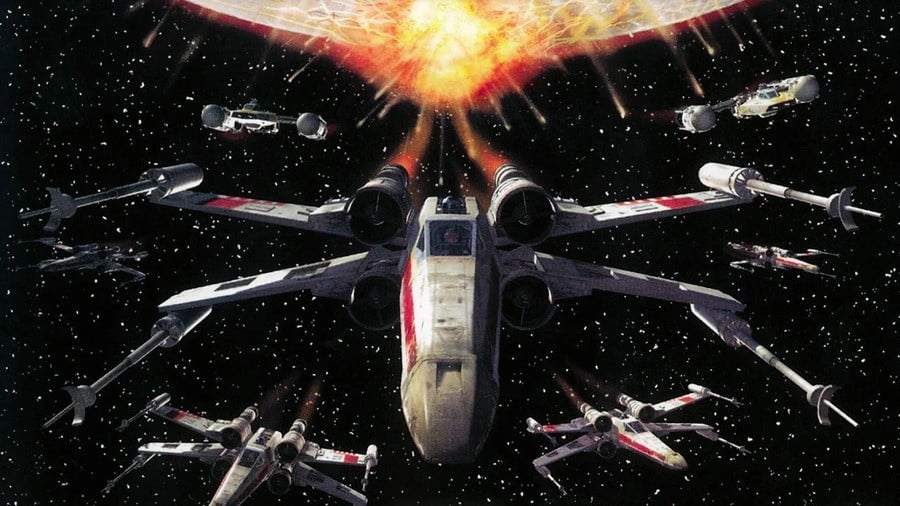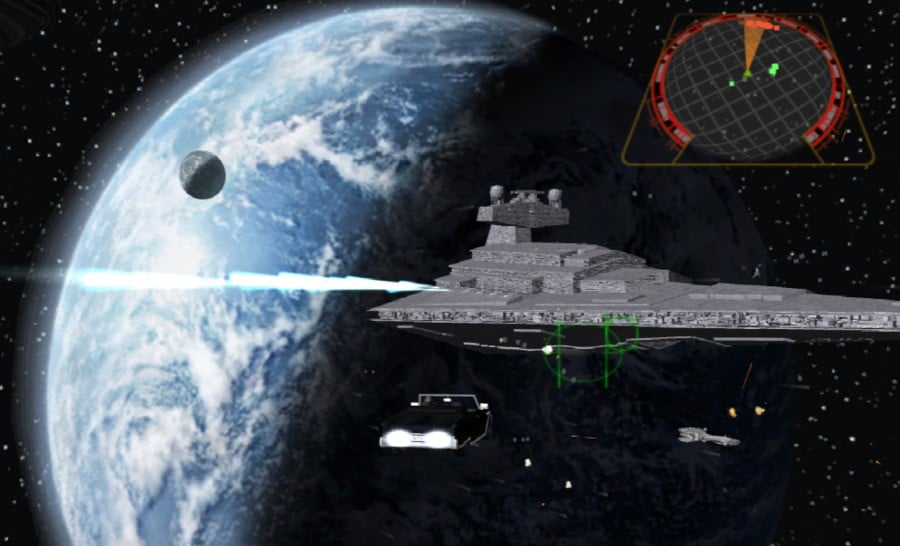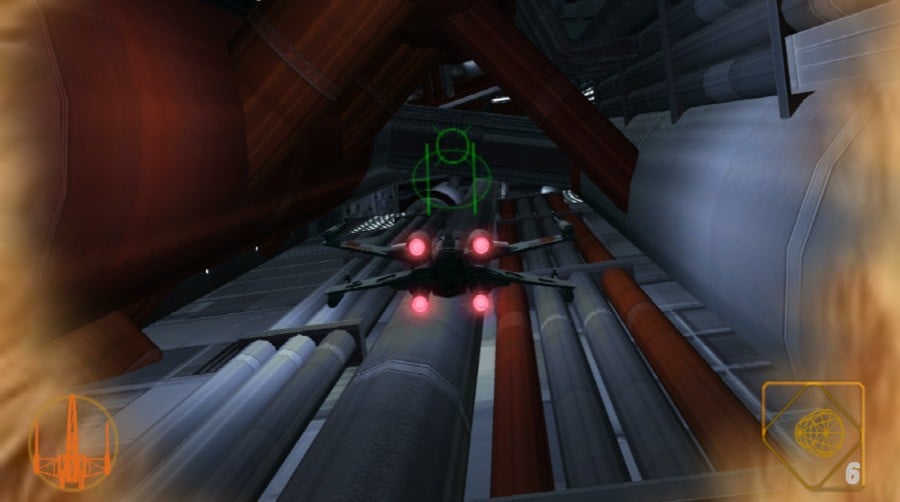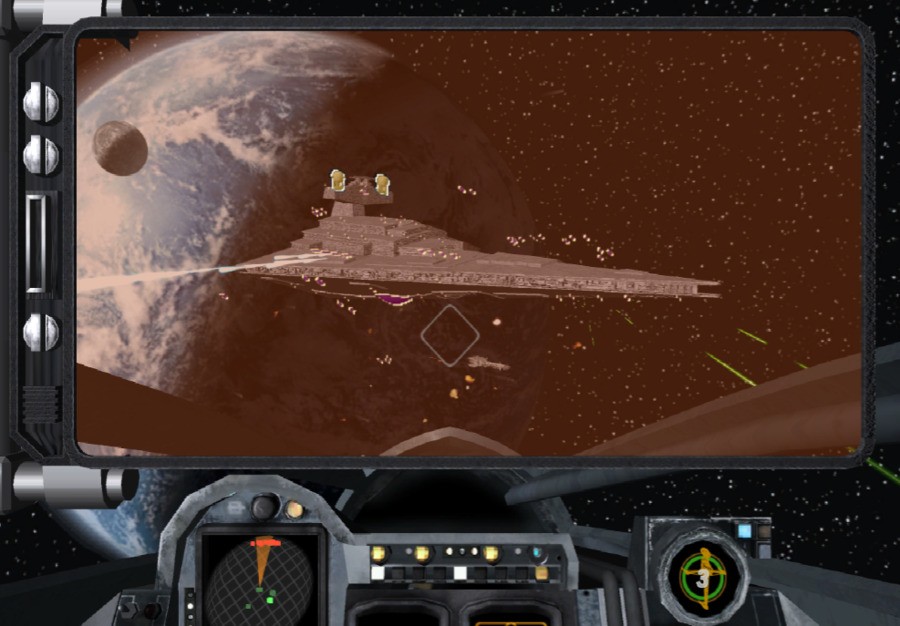
Star Wars is one of the few licensed properties that can boast a string of fantastic video games reaching all the way back to the eighties. From shooters like the Star Wars Atari arcade game to the RPG approach of Knights of the Old Republic, each key title in the franchise's history has managed to faithfully recapture the magic of a galaxy far, far away. And when it comes to Nintendo platforms, one title soars above the rest: Star Wars Rogue Squadron II: Rogue Leader, developed by Factor 5 - and overseen by LucasArts itself - as a GameCube launch title for the USA and Europe. As the second game in the Rogue Squadron series, the title benefitted hugely from the massive leap in technology made possible by Nintendo's purple wonder box, culminating in not only one of the best Star Wars games exclusive to a Nintendo console, but one of the best Star Wars games ever made.
Factor 5 already had a history with LucasArts, and its US tenure with Star Wars began with the hugely successful Star Wars: Rogue Squadron for Nintendo 64 and PC, first released in 1998, followed by the spin-off Star Wars Episode 1: Battle for Naboo in 2000. During the end of development for Battle for Naboo, Nintendo was preparing to launch the GameCube, and Factor 5 was set to be a big part of their plans. "Rogue Squadron for the N64 was a hit for Nintendo, so it made sense for them to come calling when GameCube needed a launch title," says Level Designer Albert Chen. With LucasArts's permission to start working on a new Star Wars game, Factor 5 quickly made a tech demo to demonstrate the concept for Nintendo's own Japanese trade show Space World in August 2000. "The Space World GameCube tech demo that showed off an X-wing flying over the Death Star sealed the deal," Chen states.
Although the tech demo hugely impressed those in attendance, Factor 5 had a hard road to travel, as it was only given nine months to create and finish Rogue Leader for GameCube's US launch. But it seems that the second Rogue Squadron game was not the only idea Factor 5 put forward, as Software Engineer Dean Giberson explains. "We did try to put two pitches together," he says. "I can't talk about the other game, but it was too ambitious for a launch. As a group we just couldn't see it working in the time allotted. When you looked at both pitched side-by-side, it was obvious that Rogue Leader was in much better shape."
So Factor 5 began work a stone's throw away from LucasArts, joined by a couple of their employees. The team set about crafting a game that recreated key scenes and missions of the original Star Wars trilogy. "The entire team was made up of old-school Star Wars fans." Giberson proudly states. In order to make the deadline easier to reach, Factor 5 built on work from its previous Star Wars games, as Chen explains. "Since we simply refined the game mechanics from the original Rogue Squadron and used the trademark battles from the original trilogy as narrative anchors, we were able to focus on mission design and content creation." Chen also reveals this was a common occurrence throughout the series. "We used a tool we got from LucasArts called L3D. It was a proprietary 3D mission layout editor. It was the same tool we used for Rogue Squadron, Battle for Naboo, and Rogue Squadron III: Rebel Strike, with modifications over time."

Due to Factor 5's technical prowess and focus on content, the studio could really show off what the GameCube's hardware was capable of. And when it came to visuals, Rogue Leader certainly didn't disappoint. The step-up from N64 to GameCube was enormous, with many jaws hitting the floor in percussive unison. The graphical standard was the most detailed it had been in a Star Wars game at the time, with everything from explosions and particle effects to the textures of ships and planet surfaces being nothing short of amazing. This allowed for ridiculously faithful recreations of famous ships and locations within the Star Wars lore. When asked about how the team achieved this, Chen has a simple explanation. "We had German engineers!" he laughs. "But seriously, Factor 5 developed Software Development Kits and tools that other studios used to develop for GameCube, so our engineers had intimate knowledge of the hardware and were able to fully tap into its capabilities. Being on the cutting edge of graphical innovation was our trademark."
Giberson also points out the technical differences of jumping from one generation to the next. "We knew that we were stepping into a new area with the graphics, moving from the old smudgy analogue CRTs into a digital display and 480p graphics," he says. "A lot of work went into making the GameCube shine." Like many gamers, Chen also holds the belief that the title looks great despite it being released over a decade ago, along with some interesting comments for a certain new game that bears the Star Wars licence. "I recently played the latest Battlefront and besides the high-resolution graphics, I would argue that Rogue Leader's graphics still hold up."

This new calibre of visual quality helped the missions come alive, especially those which recreated scenes from the original trilogy. Rogue Leader's campaign opened with the iconic Battle of Yavin, allowing players to control Luke Skywalker's X-Wing and take on the Death Star, a sequence Chen was eager to recreate. "As soon as I learned that we were featuring the major battles in the original trilogy, I jumped at the opportunity. I was a huge fan of the 1983 Atari vector graphics Star Wars arcade game and my trench run was heavily inspired by the obstacles in the arcade version. Also, Star Wars was the first English-language movie I ever saw after immigrating to the US from Hong Kong. I didn't understand a word of spoken dialogue, but I remembered the insane thrill that I felt during the trench run movie sequence and wanted to replicate it on the GameCube."
That wasn't the only Star Wars fantasy Chen had a hand in bringing to Nintendo players, as he also designed the Battle of Endor mission, taken from Return of the Jedi. "For the Battle of Endor, I remembered the first time I saw the Millennium Falcon fly through the swarms of TIE Fighters after the Imperial trap was sprung," he recalls. "There were so many! That's why I pushed for as many starfighters as the hardware would allow to replicate the huge numbers. I'm also a military history buff, so I was inspired by WW2 naval battles like the Battle of Midway. I made sure that TIE Fighters escorted TIE Bombers, which in turn targeted the Rebel capital ships. The TIE Interceptors would attack me, my wingmen and the Y and B-wings. In the second half of the mission, I made sure that Admiral Ackbar's cruiser flew between two Imperial Star Destroyers, which would force the player to weave in and out of the duelling capital ships."

When it comes to controlling the various ships throughout the game, Rogue Leader still boasts some of the smoothest flight controls seen in any Star Wars game, fitting the GameCube's chunky controller a treat. "Optimizing and maintaining a high frame rate was one component," Chen explains. "But it was also customisation towards specific game moments. Another was tuning the controls to specific mission needs. For example, we changed the control characteristics of the X-wing during my Death Star trench run because we were flying so fast that no one was able to survive in there with the standard controls. You would easily smack into the sides or the bottom of the trench. We made the controls a little more forgiving."
However, such tweaking and testing meant the team had to be patient, as Factor 5 only had access to two Dolphin development kits in total. "The toughest thing was waiting around to test levels and content because we only had one Dolphin dev kit for the dev pit of about sixteen," Chen recalls. "That meant in order for me to see any changes I made in my level, I had to compile it and send it to the dev kit. Then I had to put a sticky note with my name on it at the end of the queue that was around it."

But for a licence as large as Star Wars, one has to ask the question about how much autonomy Factor 5 was allowed. Chen reveals that they were less constrained than one might think. "As long as we got Lucas's licensing approval, we were allowed a fair amount of freedom, especially with the original missions." He also explains his wide scale of research in order to back up any proposed ideas. "I did a lot of research into obscure Star Wars lore to increase the chances that we got approval. I looked at everything from the Star Wars role-playing books to the radio dramas and even the Marvel comic books and expanded universe stuff. Jaxxon the green space rabbit, anyone?" Giberson also backs up the feeling of cooperation and freedom provided by LucasArts. "Brett Tosti was our LucasArts producer, and he was over constantly talking about things, but we never felt constrained, more that it was a co-development. We had the Star Wars universe to work within, and there are always constraints that needed to be checked against, but since we were all fans it worked."
This wide breadth of material within the Star Wars licence was reflected in the many unlockables, passcodes and Easter eggs found in Rogue Leader - the most amusing includes a black Buick that fired lasers and missiles. But there were some secrets that didn't make it in. "I know we cut a lot of options early on to control scope, you find most of that in Rebel Strike," explains Giberson. "But I do know that there are some Easter eggs that were cut, like having an actual chicken for a chicken walker."

For this much depth and content to exist in any Star Wars game is a feat, but to achieve it in nine months was phenomenal. And Giberson is quick to remind us of the strain the deadline put on the team. "It was the most hectic nine months of my life," he recalls. "I lived the closest to the office and was often the first one in for the day. We would work until 10 pm normally, but I know of days when I left at 4 am. I would ride my motorcycle home, fall into bed, and get up at 8 am to go back. We would all eat supper together in the main kitchen at 5pm and continue working." Giberson knows why the team endured this, and got the project done on time. "We had the people, the content, and the passion to make it happen."
After the long chaotic crunch, Rogue Leader was released to huge critical praise and became a system seller during the GameCube's launch in the US and Europe. It also remains one of the console's best exclusives. Factor 5 would go on to make the third Rogue Squadron game, Rebel Strike, which stretched the technical capabilities of the GameCube further. Whilst it added some lacklustre on-foot sections, it still contained some brilliant vehicle-based missions and also managed to include the entirety of Rogue Leader's campaign as a co-op mode.
Unfortunately, like several GameCube exclusives, Rogue Leader has never seen a re-release. What's worse is the fact that a Rogue Squadron Trilogy was completed for the Wii - provisionally named Star Wars: Rogue Leaders - but never saw release. However, with the recent surprise of SNES exclusive Super Star Wars being re-released for PS4, who knows what the future will bring for Leader and the Rogue Squadron trilogy? As the run-up to a new saga begins, be sure to load up your old disc, lock S-foils in attack position, and relive the GameCube magic all over again. And if you've never delved into Rogue Leader, then locate a copy and strap yourself in for one of the best Star Wars experiences there is. May the force be with you.

